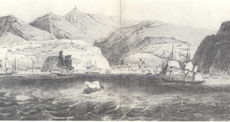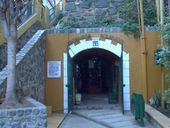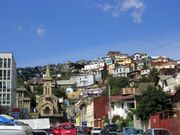Valparaíso
2007 Schools Wikipedia Selection. Related subjects: Central & South American Geography
Valparaíso is Chile's most important seaport and an increasingly vital cultural centre. The city is located in central Chile, where it is capital of the Region of Valparaíso. Valparaiso is also home of the National Congress. Built upon dozens of steep hillsides overlooking the Pacific Ocean, Valparaíso boasts a labyrinth of streets and cobblestone alleyways, embodyng a rich architectural and cultural legacy. Valparaíso is protected as a UNESCO World Heritage Site and is often considered to be one of Latin America's most intriguing urban areas.
In 2003, the Chilean Congress declared Valparaíso to be "Chile's Cultural Capital" and home for the nation's new cultural ministry. Although technically only Chile's 6th largest city, with 263,499 inhabitants (2002 census), the Greater Valparaíso metropolitan area, including the neighboring resort city of Viña del Mar, is the second largest in the country (803,683 inhabitants).
Valparaíso played an important geopolitical role in the second half of the 19th century, when the city served as a major stopover for ships traveling between the Atlantic and Pacific oceans by crossing the Straits of Magellan. Always a magnet for European immigrants, Valparaìso mushroomed during its golden age, when the city was known by international sailors as "Little San Francisco" or "The Jewel of the Pacific."
Examples of Valparaíso's former glory include Latin America's oldest stock exchange, the continent's first volunteer fire department, Chile's first public library, and the oldest Spanish language newspaper in continuous publication in the world. The opening of the Panama Canal and reduction in ship traffic, dealt a staggering blow to Valparaíso, though the city has staged an impressive rennaissance in recent years.
Valparaíso is located in central Chile, 120 km (74 miles) to the northwest of the capital Santiago. The city is an important educational centre with nine universities. Major industries include tourism, culture, and transport. Valparaíso stages a major festival attended by hundreds of thousands of participants on the last three days of every year. The festival culminates with a "New Year's by the Sea" fireworks show, attended by a million tourists who fill the coastline and hillsides with a view of the bay.
Approximately 50 international cruise ships call on Valparaíso during the 4-month Chilean summer. The port of Valparaíso is also an important hub for shipping of container freight, and exports of wine, copper, and fresh fruit.
Travel between Valparaíso and Santiago currently takes some 70 minutes on a state-of-the-art toll road.
The Chilean Congress meets in a modern building in the Almendral section of Valparaíso, after relocation from Santiago during the last years of the military rule of general Augusto Pinochet. Although congressional activities were to be legally moved by a ruling in 1987, the newly built site only began to function as the seat of Congress during the democratically-elected government of Patricio Aylwin, who followed Pinochet, in 1990.
The historic quarter of Valparaíso was declared a UNESCO World Heritage Site in 2003.
History
Valparaíso's bay was first populated by Changos, an ethnic group dedicated to fishing and gathering. Spanish explorers arrived in 1536, on the Santiaguillo, a ship sent by Diego de Almagro, considered the first European explorer of Chile. The Santiaguillo carried men and supplies for Almagro's expedition, under the command of Juan de Saavedra, who named the town after his native village of Valparaíso de Arriba in Cuenca, Spain.
During Spanish colonial times, Valparaíso remained a small village, with only a few houses and a church. After Chilean Independence from Spain, Valparaíso became the main harbour for the nascent Chilean navy, and opened to international trade, which had been limited to commerce with Spain and its other colonies. Valparaíso soon became a required stopover for ships crossing between the Atlantic and Pacific oceans via the Strait of Magellan and Cape Horn, and gained particular importance supporting and supplying the California Gold Rush (1848-1858). In its role as a major seaport, Valparaíso received immigrants from many european countries, mainly from England, Germany, France, Switzerland and Italy. German, French, Italian and English were commonly spoken among its citizens, who also had newspapers in these same languages.
International immigration transformed the local culture from its Spanish origins. Football (soccer) was introduced to Chile by the English immigrants, and the first private and catholic school in Chile was founded by french inmigrants in Valparaíso: Le Collège de Les Sacrés Coeurs (The Sacred Hearts School) which has been working for about 170 years in this city. In Valparaiso, there were also founded the firsts non-Catholic schools by immigrants from England and Germany (The MacKay School, and Der Deutsche Schule respectively). Immigrants also formed the first volunteer fire-fighting units (still a volunteer activity in Chile), while architecture reflected European styles.
The golden age of Valparaíso's commerce ended after the opening of the Panama Canal, as most ships sought to avoid the Strait of Magellan, and the port's importance and use was reduced substantially. Traffic has increased in the last few decades with fruit exports and increasing opening of the Chilean economy to world commerce.
Today
Though San Antonio has taken the reins as the country's most commercially important seaport, the City of Valparaíso remains a vibrant centre of Chilean culture, and the Greater Valparaíso metropolitan area (which includes Valparaíso, Viña del Mar, Quilpué and Villa Alemana) has the second largest concentration of population in the country after Gran Santiago.
Nicknamed "The Jewel of the Pacific", Valparaíso was declared a world heritage site based on its industrial heritage, improvised urban design, and unique architecture. The official Unesco declaration also places exceptional emphasis on Valparaíso's unique "intangible heritage," which includes the city's ethnic heritage as seen through the traditions and life styles of Valparaíso's immigrant communities.
Immortalized in the words of Pablo Neruda as the 'Ocean's sweetheart' ("novia del océano"), the city that 'goes to Paradise' (Va al paraíso) is one of Chile's —if not South America's— most charismatic and historic ports, with its charming "ascensores" (funiculars) and colorful hillside houses. Valparaíso's road infrastructure is under substantial improvement at present, particularly with the upcoming completion of the "Curaima - Placilla - La Pólvora" highway bypass, which will permit trucks to go directly to the port facility over a modern highway and through tunnels, without driving through the historic and already congested downtown streets. In addition, roads to link Valparaíso to San Antonio, Chile's second largest port, and the coastal towns in between (Laguna Verde, Quintay, Algarrobo, and Isla Negra, for example), are also under various degrees of completion.
A new, regional Metro system, opened to the public on 24 November 2005, updated the railroad that joined Santiago and Valparaíso (and cities in between, finished in 1863). The new metro constitutes the so-called "fourth stage" ("Cuarta Etapa" in Spanish) of Metropolitan improvements. The metro railway extends along most of Gran Valparaíso and is the second metro system in operation in Chile (after Santiago's), and includes an underground section that crosses Viña del Mar's downtown.
Culture
During Valparaíso's golden age (1848-1914) the city received large numbers of immigrants, primarily from Europe. The immigrant communities left a unique imprint on the city's architecture. Each community built its own churches and schools, while many also founded other noteworthy cultural and economic institutions. The largest immigrant communities came from England, Germany, and Italy, each developing their own hillside neighbourhood, preserved today as National Historic Districts or "Zonas Típicas."
During the second half of the twentieth century, Valparaíso experienced a great decline, as wealthy families de-gentrified the historic quarter, moving to bustling Santiago or nearby Viña del Mar. By the early 1990s, much of the city's unique heritage had been lost and many Chileans had given up on the city. But in the mid 1990s, a grass roots preservation movement blossomed in Valparaíso.
In 1996, the World Monuments Fund declared Valparaíso's unusual system of funicular elevators (highly-inclined cable cars) one of the world's 100 most endangered historical treasures. In 1998, grassroots activists convinced the Chilean government and local authorities to apply for UNESCO world heritage status for Valparaíso.
One such activist group was the "Fundación Valparaíso" or Valparaíso Foundation, founded by a contemporary North American Poet, Todd Temkin, who fell in love with the city while teaching literature at the Catholic University of Valparaíso. The Valparaíso Foundation has executed major neighbourhood redevelopment projects; has improved the city's tourist infrastructure; and administers the city's jazz, ethnic music, and opera festivals; among other projects.
Some noteworthy foundation projects include: "The World Heritage Trail"; "Opera by the Sea"; and Chile's "Cultural Capital".
Valparaíso was declared a World Heritage Site in 2003, thanks to its historical importance, natural beauty (large number of hills surrounding a picturesque harbour), and unique architecture (particularly, a mix of 19th century styles of housing).
Valparaíso's newspaper, "El Mercurio de Valparaíso", claims to be the oldest Spanish-language newspaper in circulation in the world.
"Fundación Renzo Pecchenino, LUKAS" maintains the drawings and paintings of the artist/cartoonist who came to symbolize Valparaíso in popular culture, in a newly restored building on Cerro Concepción, overlooking the bay.
Valparaíso is also home to the so called " School of Valparaíso", which is in fact the Faculty of Architecture & Urbanism of the Pontificia Universidad Católica de Valparaíso. The "School of Valparaiso" is one of the most experimental, avantgarde and controversial Architectural schools in the country.
The city has the second largest concentration of universities in Chile, and is home to five major universities:
- Universidad Técnica Federico Santa María
- Pontificia Universidad Católica de Valparaíso
- Universidad Adolfo Ibáñez
- Universidad de Valparaíso
- Universidad de Playa Ancha
Valparaíso is the birthplace of many historically significant figures, including Augusto Pinochet, Salvador Allende, Roberto Ampuero, author of the internationally published novels about the private eye Cayetano Brulé, and Australia's third Prime Minister John Christian Watson among them. It has also been the residence of many artists like Pablo Neruda and Nicaraguan poet Rubén Darío.
The nightlife in Valparaíso claims to be te best in the Country, there is a tradition from the sailors, who comes to the Harbour sector to drink and in this sector are large number of bars, some of them in activity even today. For example "Bar La Playa" near Sotomayor Square. The big proportion of University students keeps the tradition alive and a huge number of nightclubs, bars and discotheques turns some nights into day. A vivid guide of Valparaiso can be found in the novels of Cayetano Brule, the private detective who lives in a Victorian house in the pictoresque Paseo Gervasoni, Cerro Concepcion.
Sports
Valparaíso Maratón Bicentenario is an international marathon, based in the tourist areas of and around Valparaíso. On September 24, 2006, we will have the first event, over two distances: 10 km and 21 km, in 12 categories, both for Ladies and Gentlemen. The race will start at Plaza Sotomayor, and the course will cross diverse architectural landmarks, for which Valparaíso owes to be known as "the Pacific's Jewel". Other event is "Valparaiso Downhill", a mountain bike race. This event is in February.




